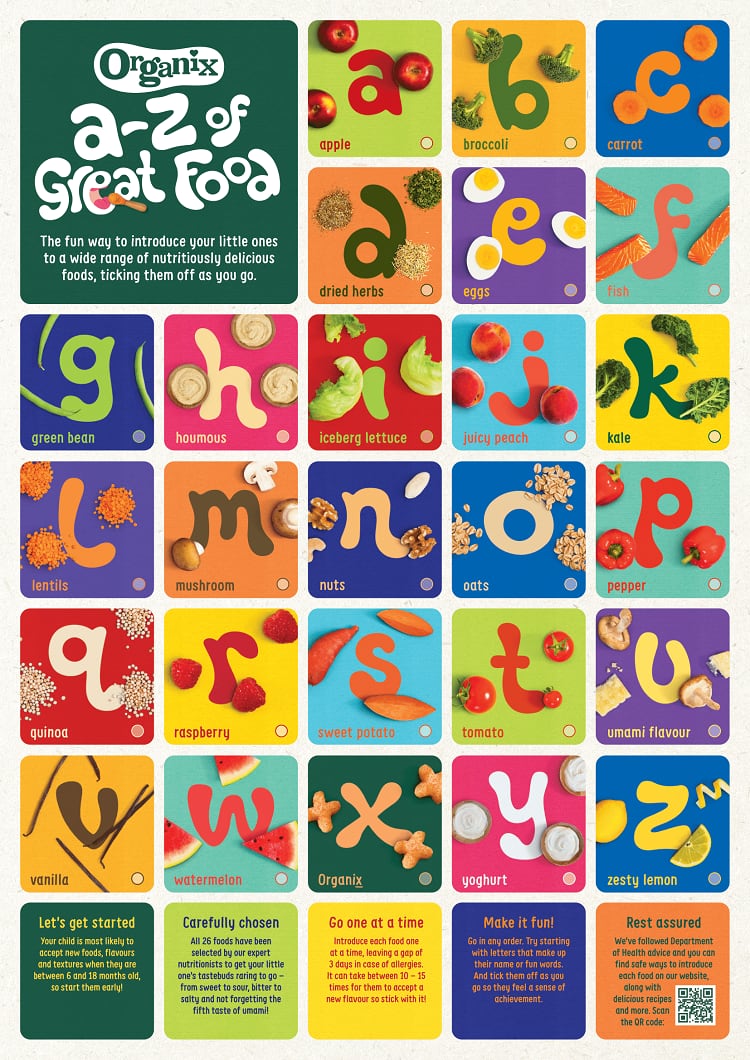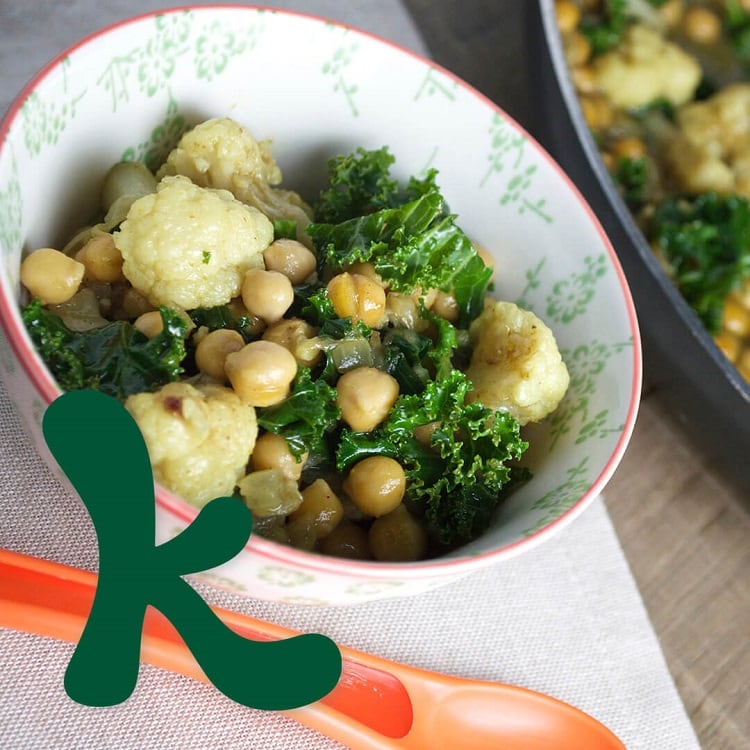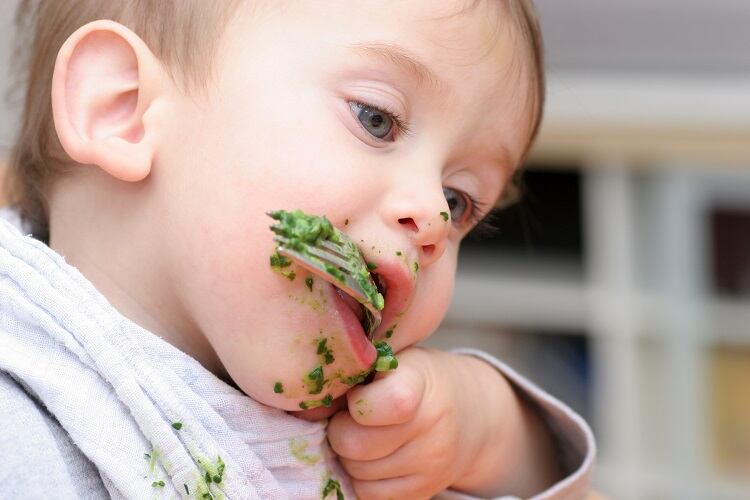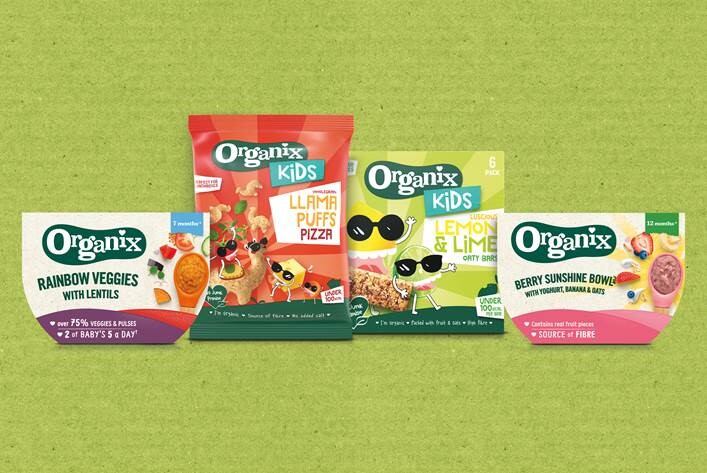Food neophobia is the tendency to reject or be reluctant to try new and unfamiliar foods. Considered a normal stage in development, Hero Group-owned Organix has observed it kicking in after the 18-month mark.
“We spend a lot of time talking to parents, carers, nutritionists, and dieticians about what’s important to them on their babies’ food and eating journeys. They say that to raise happy healthy eaters, in their first 6-18 months there is a real window of opportunity to try many different tastes and textures,” explained Mandy Bobrowski, marketing director at the UK-based child food brand.
Often from the 18-month mark onwards, children can become ‘a little bit more fearful’ about new foods, which can make introducing variety into diets ‘trickier’, she told media during a recent press briefing.
In response, Organix has developed an A-Z of Great Food campaign to help encourage the introduction of 26 new foods or flavours to kids’ diets. “We want this to be a really fun, interesting and insightful way of helping parents introduce nutritionally delicious flavours and textures to their families,” said Bobrowski. “It’s about celebrating food in those early years.”
An evidence-based selection of 26 foods and flavours
The campaign is made up of an A-Z style wall chart as well as age-appropriate recipes, tips and advice available online.

The list of 26 flavours and ingredients was selected to encourage diverse and nutritious diets and according to Organix, range from ‘favourite fruits to challenging vegetables, bitter tastes to unusual textures’. The letter ‘A’ stands for the predictable apple, but more out-of-the box letters include ‘D’ (dried herbs), ‘H’ (houmous’), ‘L’ (lentils), ‘N’ (nuts), and ‘U’ (umami flavour).
“It was important we had a diversity of ingredients that had different textures and different flavours, but also provided different nutrients and health benefits,” explained Organix nutritionist Michelle Klerks.
Organix’s nutritionist team initiated the project by developing a ‘huge’ database of foods and flavours. The first step was to identify the list of recommended foods from the age of 6-months as per NHS guidelines.
Once those were added to the database, the team turned to research undertaken by Umeå University in Sweden. The OTIS study explored the impact on eating behaviours of systematically exposing weaning infants to a variety of vegetables and fruit, including those with more sour and bitter flavours. The study found that a diet rich in variety not only fulfils a fast-growing infant’s nutritional needs, but also led to significantly higher intake of vegetables and fruit as they grew older. “We looked at the fruits and vegetables that were included in the study and added them to the database,” recalled Klerks.
More research, as well as Organix’s own recipe archive, was examined to complete the database.
To whittle it down to 26 foods and ingredients, the nutritionists grouped each item into food groups, for example fruit, vegetable, dairy, or starchy foods. Distinctions based on colour, taste and texture were made to ensure variety, and nutrition and availability analysed.
“Finally, we chose on ingredient or flavour per letter, and then went back to science to further substantiate our selection – mainly looking at health benefits…and serving suggestions,” explained the nutritionist.
From 6-18 months and beyond
The campaign was also informed by YouGov research commissioned by Organix revealing that kids in the UK are not getting enough good foods in their diet, explained Klerks. Only one-quarter of children are eating just three portions of fruit and veg daily, and under half of parents say their kids have eaten six varieties or less of fruit and veg in the past week.

The research also suggested that more than half of parents struggle to think of new ideas of how to get their children to try new foods, with one-third attempting to hide foods, mask foods or flavours, or use treats to reward kids when they try new foods. “But what stood out most, is that 40% of parents said easy tips and guidance on fun ways to use fresh foods would be a great support for them,” said the nutritionist. “That’s how the idea of A-Z came to life.”
Klerks continued: “We hope it will encourage families to explore a new range of ingredients when they are creating meals at home with their children, or even together with their children.”
But the campaign is not solely focused on the 6-18-month-bracket, FoodNavigator understands.
Yes, children need varied and balanced diets to grow and thrive, but they also help turn kids into ‘great eaters’ when they’re older as well, explained independent dietician and Mummy Nutrition founder Nichola Ludlam-Raine.
“Food refusal can be a real challenge and although the majority of children with the right approach and support do grow out if it, unfortunately if the wrong approaches are applied – for example pressure, forcing a child to eat, or having stressful or anxiety-provoking mealtimes – then poor eating habits can continue into later life.
“Strategies to help with food refusal include involving children in decisions around food, preparing food, laying the table, or deciding what to cook. And this is where the wall chart fits in perfectly because it’s so interactive.”




